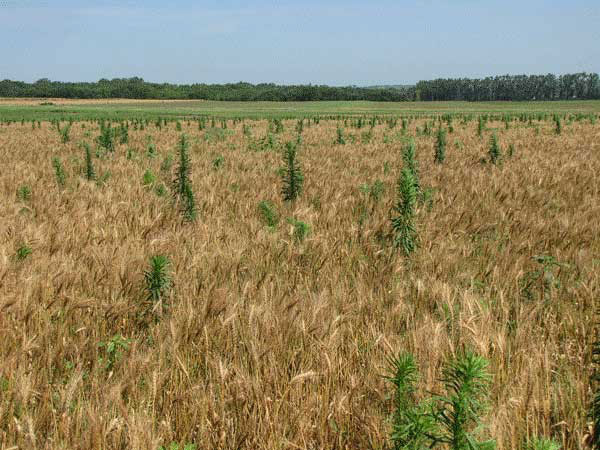A warm spring this year has resulted in rapidly maturing wheat. There have been some recent questions about spraying herbicides on wheat that has already headed. Unfortunately, there are few herbicide options to spray after wheat has reached the boot stage, and those products generally require an application either before the flag leaf emerges or before wheat reaches the boot stage. For example, products containing fluroxypyr (Starane, others), bromoxynil (Moxy, others), and Group 27 herbicides (Huskie and Talinor) were discussed in this recent eUpdate article on the control of late-emerging kochia in wheat. Once wheat reaches the boot stage, the next opportunity to apply herbicides comes at the hard dough stage. These would be considered harvest aid applications. The decision to spend resources on a herbicide application that will not directly influence crop yield is difficult; however, pre-harvest applications may be beneficial this year to prevent harvest difficulties, dockage problems, weed seed production, and soil water depletion due to weeds.
Herbicides labeled for use as harvest aids in wheat are listed in Table 1. There are differences in how quickly they act to control the weeds, the interval requirement between application and grain harvest, and the level or length of control achieved. All of them will require thorough spray coverage to be the most effective. Paraquat is sometimes mentioned as a possible herbicide for pre-harvest application but is not labeled for pre-harvest treatment in wheat. Application of paraquat to wheat is an illegal treatment and can result in quarantine and destruction of the harvested grain, along with severe fines.

Figure 1. Weeds in wheat near harvest time. Photo by Dallas Peterson, K-State Research and Extension.
Table 1. Herbicides for use a pre-harvest weed control options in wheat.
|
Herbicide |
Weeds controlled |
Application timing |
PHI* (days) |
Comments |
|
Metsulfuron |
Some broadleaf weeds |
Hard dough stage |
10 |
|
|
2,4-D LVE |
Broadleaf weeds |
Hard dough stage |
14 |
Weak on kochia and wild buckwheat |
|
Dicamba |
Broadleaf weeds |
Hard dough stage and green color is gone from nodes |
7 |
Do not use treated wheat for seed unless a germination test results in 95% or greater seed germination. |
|
Glyphosate |
Grasses and broadleaf weeds |
Hard dough stage (30% or less grain moisture) |
7 |
|
|
Carfentrazone (Aim EC, others) |
Pigweeds, kochia, lambsquarters, Russian thistle, wild buckwheat |
|
7 |
|
|
Saflufenacil (Sharpen) |
Broadleaf weeds |
Hard dough stage (30% or less grain moisture) |
3 |
|
*PHI = Pre-harvest interval, or days required between application and harvest.
For more detailed information, the “2024 Chemical Weed Control for Field Crops, Pastures, and Noncropland” guide is available online at
https://www.bookstore.ksre.ksu.edu/pubs/CHEMWEEDGUIDE.pdf or check with your local K-State Research and Extension office for a paper copy.
The use of trade names is for clarity to readers and does not imply endorsement of a particular product, nor does exclusion imply non-approval. Always consult the herbicide label for the most current use requirements. Users should read and follow all label instructions.
Sarah Lancaster, Weed Management Specialist
slancaster@ksu.edu
Tags: wheat weed control herbicide application pre-harvest harvest aid